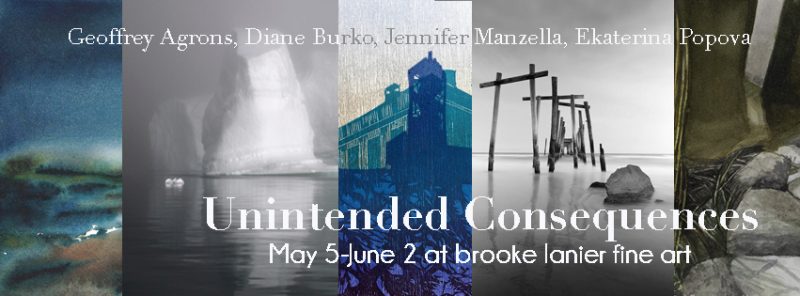
Fluid Dynamics, Geoffrey Agrons, Sebastien Leclercq, Deborah Weiss, and Brooke Lanier
820 S. 4th Street, Philadelphia, PA 19147
Phone: 267-329-9653
Email: brooke.lanier@gmail.com
Website: brookelanier.com/fluid_dynamics
Fluid Dynamics
Geoffrey Agrons, Sebastien Leclercq, Deborah Weiss, and Brooke Lanier
November 15, 2019 – January 3, 2020
Opening Reception Friday, November 22 5:30pm – 8:00pm
Holiday Party Friday, December 20, 5:30pm-8pm
Water inspires a unique fascination as a visually complex, mesmerizing substance that is also essential for human life. From the pristine to the toxic, turbulent to placid, Fluid Dynamics assembles a collection of photographs and paintings that address a diverse spectrum of ways of depicting, contemplating, and interacting with bodies of water.
Deborah Weiss’s oil paintings on panel are the most abstract and gestural pieces in the show, utilizing an intriguing absence of contextual cues as to the scale of the subject. The palette and textures suggest shorelines with intricate deposits of silt, but they could easily be interpreted as storm systems, ocean currents, or weathered wood.
The patterns in Weiss’s paintings would feel right at home as vignettes along the shoreline of the Salton Sea in Geoffrey Agrons’s photos. In the 1950’s and 1960’s the area was home to luxury resorts. By the 1970s, agricultural runoff, evaporation, and low rainfall had rendered the water toxic and saltier than the Pacific Ocean. Massive fish die-offs, algal blooms, and related bird deaths rendered the area unattractive for those seeking a beach vacation. Other photographs capture scenes from shorelines impacted by hurricanes, pollution, and drought. Independent of this narrative, the photographs contain melancholy yet peaceful vistas punctuated by bleached driftwood and architectural relics of nautical activity.
Agrons’ ecological allegories pair with Sebastien Leclercq’s scenes of shipping vessels that damage the very environment upon which their industry depends. The views from different parts of the world, desert and arctic, imply different facets of climate change. Leclercq spent five weeks aboard several ships in the Finnish Maritime Fleet, documenting the contemporary state of an ancient tradition. The boats are so enormous that at times they seem abstracted and transformed into colorful, geometric compositional elements rather than floating factories.
Leclercq’s views of ships lend context to Brooke Lanier’s paintings. The saturated colors and hard edges of boats and docks create a collage effect in real life. Lanier pushes that line of thought and creates collage-based paintings that recombine beloved landscapes in the composited manner of unreliable memories. Alongside Leclercq’s photographs, Lanier’s paintings are reconnected to their origins, creating a dialogue.
Gallery Hours are Tuesday and Thursday 12pm – 6pm, Friday 11am – 5pm, Saturday 11am – 3pm, by appointment or chance. The gallery will be closed December 22 – 29, 2019 for the holidays and open by appointment in January.
Thank you to Brooke Lanier for the content of this post.
Like DoNArTNeWs Philadelphia Art News Blog on facebook
Follow the new DoNArTNeWs.com
Follow DoN on Twitter @DoNNieBeat58
@donniebeat on Instagram
Affiliate Marketing [disclosure page] Shop on-line and help support DoNArTNeWs
Donate via safe and secure PayPal in the sidebar.
DoNArTNeWs – celebrating eleven years reporting on Philadelphia artists and art.

